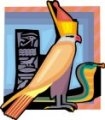
Worksheets and No Prep Teaching Resources
Reading Comprehension Worksheets
Ancient Egypt

Ancient Egypt
 Worksheets and No Prep Teaching Resources Reading Comprehension Worksheets Ancient Egypt |
 Ancient Egypt |
| edHelper's suggested reading level: | grades 7 to 12 | |
| Flesch-Kincaid grade level: | 8.5 |
| Print Hieroglyphs (font options, pick words for additional puzzles, and more) |
| Quickly print reading comprehension |
| Print a proofreading activity |
|
Hieroglyphs
By Vickie Chao |

|
 |
Create Weekly Reading Books
Prepare for an entire week at once! |
| Leave your feedback on Hieroglyphs (use this link if you found an error in the story) |
 |
Ancient Egypt
|
 |
Social Studies
|